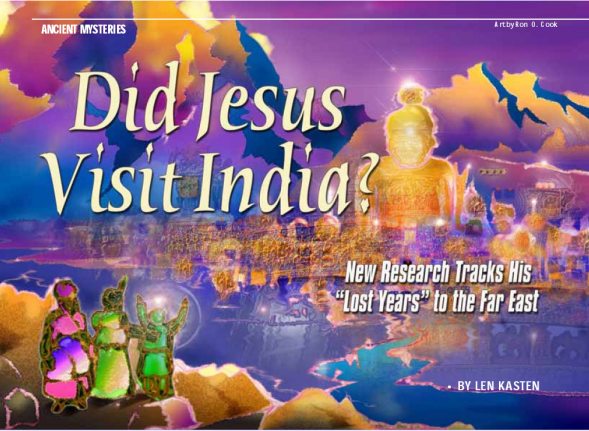
You can purhase your copy from the back store at the UFO store [here]
It appears to be a subject no Christtian wishes to discuss. Priests, bishops, ministers and laymen alike avoid it like the plague. Why? Because they have no answers. And yet, it is a simple and important question—where was Jesus between the ages of 13 and 30? Are we to understand that he spent those years laboring as a carpenter in his father’s shop? Would this have been an appropriate endeavor for a young man whose birth was heralded by angels and who was de- bating brilliantly with rabbis at the age of 12? Clearly, the man who showed up in Jerusalem at the age of 30 to undertake what he knew to be a very dangerous mission that would probably end in his death was well prepared, and one might even say “trained” for that mission, and fully confident of his ability to carry it to completion. It seems highly unlikely that he achieved that prepar- ation and confidence in his father’s carpentry shop. The failure of the Gospels to treat this subject is suspicious. Logic would dictate that his followers would want to know the history of such a “miracle-man” and self- proclaimed Son of God.
It suggests that somehow, sometime, this information may have been excised from the Gospels, perhaps at the Council of Nicea in A.D. 323 It is possible that some in the early church knew this history and found it incompatible with the new religion proclaimed by Constantine, built around the divinity of Jesus. A belief in this possibility is encouraged by the fact that the story of the so-called “lost years of Jesus” was well-known at the time—in India!
Was Jesus “a Yogi?”
In the modern era, there have been nu- merous references to the travels of Jesus in India and Tibet, and they are all remarkably consistent. Perhaps the most noteworthy is The Second Coming of the Christ by Para- mahansa Yogananda (1893-1951), originally written in the 1940s, but re-published in a slip-case edition in 2004. Yogananda, who founded Self-Realization Fellowship in Los Angeles in 1920, is best known for his classic best-seller Autobiography of a Yogi. In The Second Coming he re-casts the teachings of Jesus in the light of Eastern religious philos- ophy, taking the position that Jesus was in- fluenced by Hinduism and Buddhism, and higher esoteric Eastern wisdom, believed to be the province of the Himalayan masters. This influence, he claims, was the result of the youthful Jesus having lived and studied with monks and teachers in India and Tibet.
Such sayings as “the kingdom of heaven is within you” and “know ye not that ye are gods?” can easily be discerned as deriving from Eastern religious thought. Jesus also made indirect references to karma and rein- carnation, and much of what he taught about love and compassion seems clearly influ- enced by the teachings of the Buddha. One reviewer of The Second Coming says, “...a deeper esoteric study of what Christ was saying...this interpretation is laced with eastern mysticism and Christ is seen as a self-realized Yogi come to awaken mankind to their own cosmic consciousness.” Yogananda’s view of Jesus as a “self- realized yogi” becomes more acceptable when one takes a closer look at the “mira- cles” that Jesus performed. All of them, it is said, have been duplicated by generations of yogis in the Himalayan foothills. These powers are the so-called “siddhis” developed by years of rigorous adherence to spiritual development through yoga and meditation with the help of a guru, especially the arts of Raja Yoga. According to Shri Prakash Ji, “A yogi is one whose soul has linked to the Uni- versal Soul, one who has reached God...Yogi is within God and God is in Him. God and Yogi are Oneness.” And once this union has been achieved, the spiritual powers or "siddhis" manifest. The ability to walk on water, or to levitate, is known as "vayu-siddhi" and is considered one of the minor siddhis. Jesus was even able to teach his disciples the technique. The power to raise the dead is known as "ishitvam" and is one of the eight major siddhis. Kabir, Tulsidas, Akalot Swami and others had the power of bringing back to life the dead. Raja yogins routinely appear and disppear, heal the sick, calm the elements, and manifest solid objects out of thin air. Could the evidence that Jesus had these powers mean that he studied Raja Yoga with high yogis in India and Tibet until he become "self reliazed"?
Shangri-La
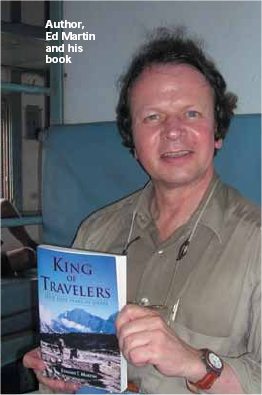
The most recent book on the subject is The King of Travellers (Jonah Publishing, 1999) by Edward T Martin. Martin travelled to India in 1974, which stationed in Kabul, Afghanistan with the Peace Corps. In what is clearly a case of synchronicity, Martin who had already read extensively on the subject of Jesus in India, came across the book Christ in Kashmir by Aziz Kashmiri in a small bookstore in Sringar, and was able to immediately meet the author through the bookstore owner. In his book, Martin describes that fateful meeting,. "...over steaming cups of tea, we had a far-ranging discussion about the subject of Jesus in India. To my surprise, I found out that in India itself there is a very long standing tradition and folklore that Jesus did indeed live in India." That meeting with Kashmiri started Martin off on a life-long research odyssey that culminated in his book twenty-five years later. We interviewed him to discuss the book, and his recent trip back to India with Hollywood producer Paul Davids, in which they traveled over 4000 miles across the continent filming a new documentary on the subject to be released in 2007.
In our interview with Martin, he focused on the so-called “chain of evidence,” i.e., all the reliable sources of information on the subject. In his book, he mentions Edgar Cayce, who made frequent references to the travels of Jesus, and The Aquarian Gospel of Jesus the Christ by Levi Dowling, first published in 1907. Martin’s opinion is that the most thorough coverage of this subject is to be found in The Lost Years of Jesus by Eliza- beth Clare Prophet (1984, Summit Univer- sity Press). The evidence seems to revolve almost entirely around the secluded and mysterious Buddhist monastery of Himis in Leh in the province of Ladakh in northern Kashmir. Himis is a “gompa” or “solitary place of refuge from the world of temptation” prized by Buddhist monks. Prophet says that Himis is “...tucked away in a hidden valley in the Himalayas 11,000 feet above sea level. Some who have visited it say it brings to mind visions of Shangri-La.” It was to Himis that 29-year-old Russian journalist Nicolas Notovitch traveled in late 1887 because a lama had told him that he might find a manuscript there about the life of the prophet Issa who had traveled there as a young man. Issa was the Indian name for Jesus. In the course of a conversation, the chief lama at Himis mentioned that there were scrolls there in which “are to be found the life and acts of the Buddha Issa who preached the holy doctrine in India and among the children of Israel.” These scrolls in Tibetan, the lama explained, were copied from the original version kept in Lhassa and written in ancient Pali.
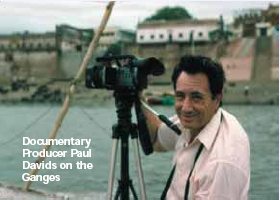
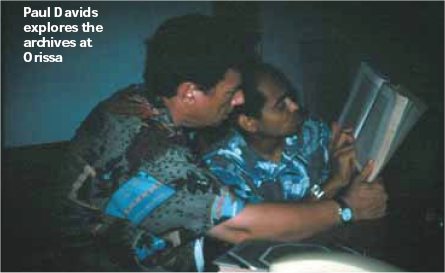
During an extended stay at Himis while convalescing from a broken leg, Notovitch persuaded the lama to show him the scrolls, “two large bound volumes with leaves yellowed by time,” and to allow him to translate and record the verses. This ultimately became the book, The Life of St. Issa: Best of the Sons of Men, published by Notovitch in 1894. It consisted of 244 of the scattered, translated verses organized by Notovitch into 14 chapters. The complete story by Noto- vitch with the verses incorporated was titled The Unknown Life of Jesus Christ. That book, originally in French, was an instant success, going through eighteen editions in France, three in the U.S. and one in England, and was translated into German, Spanish, Swedish and Italian.
Issa Preaches to the Lower Castes
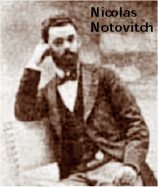
The Life of St. Issa could really be consid- ered the earliest gospel, even though related by merchants rather than disciples, since it was supposedly written in the first or second century A.D. It begins with the story of the Jewish enslavement in Egypt and ends with the Crucifixion. Regarding the departure of Jesus to India, it says that at the age of 13, he was expected to take a wife, and the modest house of Joseph and Mary became crowded with “the rich and noble” seeking to make the illustrious, brilliant youth a son-in-law. “It was then that Issa clandestinely left his fa- ther’s house, went out of Jerusalem, and, in company with some mer- chants, traveled toward Sindh (India), that he might perfect himself in the divine word and study the laws of the great Buddhas.” Almost certainly, the merchants’ camel caravan traveled over the Silk Road, the main East- West trade route.
Issa crossed the Indus River and moved on across the continent to the Temple of Jagganath in the province of Orissa in Southeast India. There, he was enthusiastically welcomed by the white Brahmin priests, and spent six years studying the Vedas, and learning how to teach, heal the sick, and per- form exorcisms, in Jagganath, Raja- griha, Benares and other holy cities. Then, in an early display of his characteristic anti- establishment trouble-making, the 21 year- old Issa defiantly preached the holy Hindu scriptures to the lower castes—the farmers, merchants and laborers, thus enraging the Brahmins and Kshatriyas (priests and war- riors), who promptly put out a contract on his life. According to the verses, “He strongly denounced the men who robbed their fellow- beings of their rights as men, saying ‘God the Father establishes no difference between his children, who are all equally dear to him.’ Warned by his friends, Issa fled to the Hima- layan foothills in Nepal, the birthplace of Gautama Buddha with whom he evidently felt a strong connection. Having learned the Pali tongue, Issa spent the next six years studying the ancient scrolls in the Buddhist monasteries of Nepal and Tibet, including Himis where he remained for about two months, until he “whom the Buddha had chosen to spread his holy word, could per- fectly explain the sacred rolls.” And then he turned his face westward, and began the fateful journey back to Palestine, to live out his hard destiny.
While popular, The Unknown Life got some rough treatment from critics, notably Max Muller, a well-known Orientalist and professor of Philology at Oxford University, who declared the book to be fraudulent in an article in The Nineteenth Century, a schol- arly review. And so, the authenticity of St. Issa remained in question for many years. Then in 1922, Swami Abhedananda traveled to the Himis Monastery to determine once and for all, whether or not Notovitch had told the truth. Abhedananda, who was 56 at that time, had lived a life of unquestioned spiritual integrity and authority having walked the length and breadth of India him- self barefoot and without money at the age of 20. In 1929, in his book Kashmir and Tibet, Abhedananda stated that while he was skep- tical at first, he was able to verify that every- thing Notovitch had said was absolutely true. Ironically, Max Muller, then deceased, had been one of the Swami’s closest friends! This confirmation of the Issa legend by such as Abhedananda might have been enough to silence the critics. But then came an even grander endorsement from an unex- pected, and very impressive source.
“These Books Say Your Jesus Was Here”
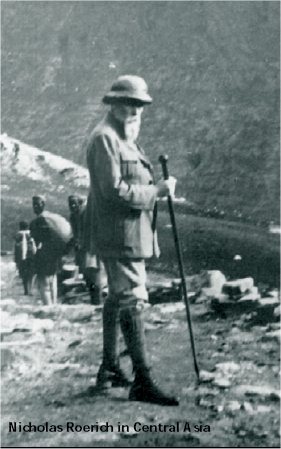
Nicholas Roerich was truly a Renaissance Man in every sense of the word. Born in St. Petersburg, Russia in 1874 to an upper-middle class family, and educated as both a lawyer and artist, Roerich was an accomplished painter, professor and art impresario during his early life, but he sought to bring all the arts to- gether. Prophet says, “Typically described in biographical notes as ‘a Russian-born painter, poet, archaeologist, philosopher and mystic,’ Roerich was also a diplomat, writer, critic, educator, set and costume designer, and explorer.” But underneath it all, the mystic prevailed, and he had a strong urge to travel to India and Tibet. In 1924, at the age of 50, his worldly success behind him, Roe- rich, his wife Helena, his two sons and Tibetan lama Lobzang Mingyur Dorje, mounted an expedition to Central Asia con- sisting of “nine Europeans, thirty-six natives, and 102 camels, yaks, horses and mules.” The eldest son, George Roerich, was a noted archaeologist and Orientalist who had studied at Harvard and the School of Oriental Languages in Paris. He was conversant in Persian, Sanskrit, Chinese and all of the many Tibetan dialects. One of the several goals of the journey was the study of ancient monuments and the conditions and origins of contemporary religions.
Unexpectedly, wherever they traveled, they heard legends about Jesus. In his book Altai-Himalaya published in 1929, which was more of a travel diary, he says, “In Srin- igar we first encountered the curious legend
about Christ’s visit to this place. Afterwards, we saw how widely spread in India, in Ladak and in Central Asia, was the legend of the visit of Christ to these parts...” He said further that he heard several versions of the legend, but that they all agreed on one point, “that during the time of His absence, Christ was in India and Asia.” Then Roerich started hearing about the manuscript of the life of St. Issa. In his second book, Himalaya, he writes about Himis. “Regarding the manu- scripts of Christ—first there was a complete denial... Then slowly, little by little, are creeping fragmentary reticent details, diffi- cult to obtain. Finally, it appears—that about the manuscripts, the old people in Ladak have heard and know.” Roerich knew about Notovitch’s book. He says, “Many re- member the lines from the book of Noto- vitch, but it is still more wonderful to dis- cover, on this site, in several variants, the same version of the legend of Issa.”
There were others after Roerich. In the summer of 1939, Madame Elisabeth G. Cas- pari, a Swiss musician, and her husband were on a pilgrimage to Mt. Kailas in Tibet, and stopped at Himis on the way. While seated on the roof of the convent, she was approached by the librarian of the monastery, and two monks. They carried three manuscripts with elegant coverings. As he carefully unwrapped the parchment leaves, the librarian said to her, “These books say your Jesus was here.”
All of these reports basically take the posi- tion that Jesus was a conscious disciple of Guatama Buddha, and that’s why the monks at Himis treated the manuscript so rever- ently. Some believe that he was actually a re- incarnation of the Buddha. They claim that he understood that his mission was to spread the Buddhist doctrine in the West, and that Christianity is simply a Westernized version of Buddhism. There have been several books on this subject, giving impressive lists of par- allels between Buddhism and Christianity. This idea argues for a long and hoary history of continued and connected revelations by successive “standard bearers” coming at pre- cise intervals, and all dedicated to elevating the spiritual consciousness of the human race. From this perspective, it certainly makes sense that the young Jesus, conscious of the role he was to play, would travel to the only place on the planet where he knew he could be prepared for that role.
Article Reproduced with Permission From Publisher of 'Atlantis Rising'

